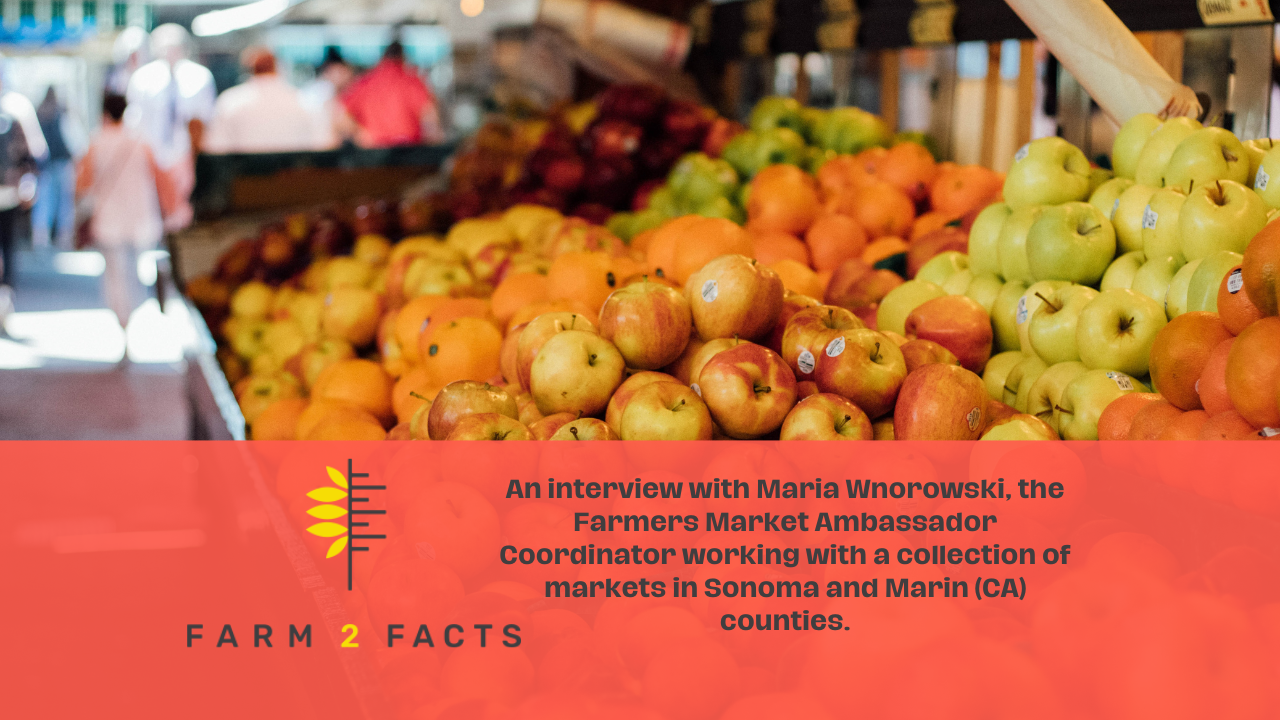
Written by Josie Reeve
Interview has been edited for clarity and length.
What is a Farmers Market Ambassador Coordinator, and what markets do you work with?
My position serves as an integral part of a Farmers Market Promotion Program (FMPP) grant, which is focused on promoting equity, inclusion, and community within farmers markets. One of our key initiatives has been to implement an ambassador program. Ambassadors collaborate directly with individual farmers markets to foster a sense of community among market managers, vendors, customers, and the broader community. This initiative is fundamentally centered on the notion of “bringing the market to the community and the community to the market.”
I collaborate with a range of farmers markets as part of the Farmers Market Local Incentive for Food and Economy (FM LIFE) consortium. This consortium works with farmers markets in Sonoma and Marin Counties. It plays a pivotal role in the ability to offer Market Match, a nutrition incentive program managed by the Ecology Center in Berkeley, CA. As part of Market Match, individuals receiving SNAP benefits, or CalFresh as we call it in California, can receive a one-to-one match up to $10 or $20, depending on the specific market. This program both empowers individuals to make healthier food choices and directs these funds to local vendors, as opposed to big-box grocery stores.
In my capacity as the Ambassador Coordinator, I crafted a comprehensive job description based on the feedback from the Farm 2 Facts team, market managers, and insights derived from a previous FMPP grant. I recruited and onboarded six market ambassadors. Currently, I am supporting them in the execution of initiatives and interventions designed to foster a stronger sense of community at the individual markets. These initiatives and interventions have been developed through extensive conversations with community partners and market stakeholders. They also incorporate priorities identified by our ambassadors through their day-to-day interactions with community members.
What motivated you to get involved in farmer’s markets?
I believe in the importance of purchasing local and supporting local vendors and producers. I shopped at a lot of farmers markets in my free time before this role. Personally, I dealt with some issues of accessibility of markets, especially as someone who worked 9 to 5. When I saw this position looking at how to make markets more inclusive and accessible to everyone, that resonated with me. I am able to support local vendors and expand their business opportunities, as well as help consumers have access to high quality, local products.
My decision to apply for the position stemmed from a deep-seated belief in the value of sourcing locally and championing local vendors and producers. Prior to taking on this role, I frequented farmers’ markets when possible, but often encountered challenges related to the accessibility of these markets, particularly as someone who worked a 9-to-5 job.
When I came across the opportunity to contribute to a position focused on improving the accessibility and inclusivity of farmers’ markets for all, it resonated with me. This role enables me to actively support local vendors and facilitate the expansion of their business prospects while simultaneously working to improve the opportunities for consumers to access premium, locally-sourced products, thereby fostering a win-win environment for both producers and consumers alike.
What kinds of goods or services does your markets provide?
There’s a huge variety of offerings at our markets, everything from produce, meat, dairy, cheese, eggs, jams and jellies, honey, and artisanal vendors who do different art, pottery and jewelry, all locally produced. One of my personal favorites is Handsome Carver’s Nut Butters who make incredible nut butters. They have a pumpkin one right now that I eat every morning for breakfast. It’s delicious!
Is there anything unique about your markets?
Each of our markets possesses its own distinctive character and charm. For instance, the Agricultural Community Events (ACE) markets, extending from Fairfax to Santa Rosa, are renowned for their vibrant and bustling atmospheres. These markets exude a remarkable energy and are distinguished by the close rapport between many of the vendors and Kelly, the market manager. Kelly consistently explores innovative ideas to foster the expansion and evolution of these markets.
Other markets, especially the Sebastopol and Santa Rosa Original Certified, boast a rich legacy, dating back to the 1960s, with enduring traditions and a storied history. These markets have cultivated a loyal following of customers and vendors, many of whom have been integral parts of these markets for decades.
One notable feature I appreciate about the Cotati, Rohnert Park, and Sebastopol markets is their central location within their respective downtown areas. These markets transcend the mere act of shopping; they serve as spaces for people to revel in live music, relish delectable hot-cooked cuisine, and spend quality time with friends and family both before and after their shopping excursions. There is a sense of unhurried joy at these markets, inviting everyone to engage in leisurely conversations, savor the unique character of the town, and embrace the opportunity to simply enjoy one another’s company. It is a good time to connect with vendors, learn about their different practices, and remind ourselves of the value in knowing the people who create the food we eat.
These markets serve as a poignant reminder of the importance of deceleration in our daily lives, emphasizing the value of meaningful exchanges with fellow community members and vendors, fostering a sense of genuine connection and shared presence.
What is your favorite/most rewarding part about what you do?
One of the most gratifying aspects of my role is orchestrating and providing guidance to our ambassadors as they bring their initiatives and concepts to fruition. This experience carries a remarkable sense of empowerment and resonance with my previous work as a high school track and cross country coach. Much like my coaching background, I now have the privilege of aiding individuals in reaching their goals and serving as their steadfast supporter. Witnessing their endeavors to construct thriving communities is particularly rewarding, and I find great satisfaction in exploring ways to further facilitate their accomplishments.
What is the most difficult part of your role?
The most formidable challenge I often encounter in my role pertains to resource limitations. This encompasses direct interactions with community members who are grappling with food insecurity and the constraint of insufficient time to deeply engage with every initiative at hand. My team and I are dedicated to combating food insecurity at the local level, whether it involves connecting individuals with the CalFresh enrollment team or gleaning surplus produce from markets for donation to senior housing communities. Yet, it’s a stark reality that many individuals in our local community continue to endure hardship, particularly in light of reductions in CalFresh benefits. Learning about the sacrifices they have to make to put food on their tables can be heavy and frustrating.
Furthermore, despite the multitude of commendable ideas and initiatives available, our work is constrained by budgetary limitations and the finite number of hours available for implementation. Prioritization of these initiatives is a constant challenge, and this process can sometimes lend an impression of gradual progress. During these moments, I remain steadfast in focusing on the long-term vision and sustainability of our efforts.
What are your future goals for your markets?
On a personal note, I am driven by the aspiration to broaden our outreach efforts to college students and young adults. Within our local landscape, we’ve successfully implemented several commendable programs aimed at bolstering food security among seniors. I envision a similar initiative tailored to college students and young adults. Farmers’ markets represent a unique opportunity for students to venture beyond campus and engage with the diverse local community, transcending the often homogenous environment of college life. Internally, our ambassador team has been actively exploring the concept of hosting designated college nights at the markets, improving transportation options to and from campuses, and developing deeper relationships with student service organizations.
Another goal that we have delved into with the Farm 2 Facts team pertains to the establishment of a food hub or food delivery service. This innovative venture would extend accessibility to Farmers’ Markets and empower individuals who rely on services like Instacart to patronize local vendors, all without the necessity of in-person visits to the market. This holds the potential to address accessibility challenges faced by individuals who are often unable to attend the farmers’ market in person, whether that be transportation limitations, schedule conflicts, or anything else.
